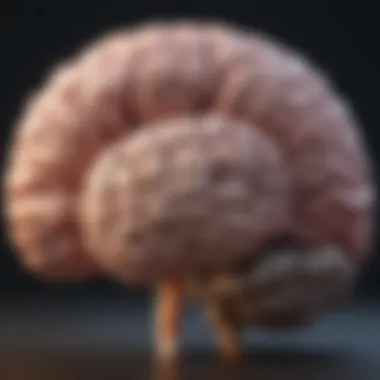Understanding Brain Cancer Prognosis: Survival Insights


Research Overview
Understanding the prognosis for brain cancer involves examining the intertwining factors that contribute to life expectancy and survival rates. This body of research highlights not simply the statistical data but the real-life implications that these figures hold for patients and their families. Various types of brain tumors, such as glioblastoma, meningioma, and astrocytoma, contribute uniquely to the prognosis. Moreover, advances in treatment modalities and personal patient factors significantly refine what one can expect after diagnosis.
Summary of Key Findings
Life expectancy in brain cancer patients can vary dramatically, influenced by multiple factors:
- Type of Tumor: Each type has different growth patterns and responses to treatment.
- Patient Age: Younger patients often have better survival rates compared to older adults.
- Treatment Advances: Innovations such as targeted therapy and immunotherapy improve outcomes.
- Overall Health: Pre-existing health conditions can affect treatment tolerance and prognosis.
Such findings affirm that prognosis is not a one-size-fits-all estimate.
Importance of the Research
With brain cancer’s complex nature, understanding prognosis helps foster informed decision-making for patients and their families. This knowledge is crucial not just for choosing treatment paths but also for emotional preparedness and planning for the future. Moreover, healthcare professionals gain insights that can tailor treatments to individual patient profiles, ultimately aiming for improved patient outcomes.
Methodology
This section outlines the approach taken in examining the available data and insights into brain cancer prognosis. The methods used provide a roadmap to understanding the depth of research into survival rates and influencing factors.
Study Design
The studies reviewed encompass a wide range of methodologies, including:
- Longitudinal Studies: Tracking patient outcomes over an extended period.
- Meta-Analyses: Collating data from various research sources for comprehensive insights.
- Clinical Trials: Evaluating the effectiveness of new treatments through controlled environments.
Data Collection Techniques
Data collection in this field often employs several techniques:
- Surveys: Gathering firsthand accounts from patients about their experiences.
- Medical Records Analysis: Examining hospital data for survival metrics and treatment efficacy.
- Statistical Modeling: Using algorithms to predict outcomes based on existing data.
Through these approaches, researchers enhance understanding of brain cancer prognosis, delivering nuanced insights that are critical for patients and the medical community alike.
Preface to Brain Cancer
The topic of brain cancer holds significant weight in both medical and personal contexts. Understanding this condition is crucial for patients, caregivers, and healthcare professionals alike. Brain cancer encompasses a variety of tumor types, each presenting unique challenges and prognostic factors. This article aims to shed light on the intricate aspects related to brain cancer, focusing on life expectancy and survival influences. By exploring both statistical insights and personal experiences, we can grasp the profound impact this disease has on individuals and communities.
Defining Brain Cancer
Brain cancer refers to the presence of malignant tumors in the brain. These tumors can be classified as primary, originating in the brain itself, or secondary, which spread from other parts of the body. Understanding the differentiation between tumor types is essential for diagnosis and treatment decisions. For instance, gliomas and meningiomas are primary tumors that differ markedly in their behavior and treatment response. Research suggests that incidence rates can vary based on age, sex, and geographic location, highlighting the complex portrait of brain cancer.
Prevalence and Types
The prevalence of brain cancer has raised alarm among healthcare practitioners. Statistics indicate that brain tumors account for a small percentage of all cancers but represent a significant cause of cancer-related mortality. The American Brain Tumor Association notes that approximately 54,540 people will be diagnosed with a brain tumor in 2023. Various types exist, including:
- Glioblastoma Multiforme: Highly aggressive with poor prognosis.
- Astrocytomas: Tumors arising from astrocytes with varying grades.
- Meningiomas: Generally benign, often requiring surgical intervention.
Understanding these statistics not only informs treatment options but also shapes public health strategies aimed at early detection and intervention.
Symptoms and Diagnosis
Symptoms of brain cancer can be deceptive. They often mimic other less severe conditions, making timely diagnosis challenging. Common symptoms include:
- Headaches: Persistent and worsening over time.
- Seizures: New-onset seizures in adults may indicate brain tumors.
- Cognitive Changes: Memory problems or personality shifts.
- Motor Dysfunction: Weakness or coordination issues.
Diagnosis typically involves imaging techniques like MRI or CT scans, along with a thorough neurological examination. Confirmation of cancer often requires a biopsy. Understanding symptomatology and diagnostic pathways is vital for early intervention, influencing the overall prognosis and treatment outcomes.
Understanding Life Expectancy


Understanding life expectancy in brain cancer is a vital aspect of discussing this disease. It not only shapes the expectations of patients and their families but also enhances medical planning and decision making. Knowing the average prognosis can provide patients with necessary information as they navigate their treatment options and future planning.
Life expectancy in brain cancer is influenced by a multitude of factors, including age, overall health, and tumor characteristics. This section will explore key statistical insights and survival rate considerations that shed light on the complexities surrounding brain cancer prognosis.
Statistics and Averages
Statistics and medical research provide a foundation for understanding life expectancy in brain cancer. The average survival rates typically reflect a combination of factors, including the type and grade of tumor, patient age, and treatment responsiveness. According to current data, the five-year survival rate for brain cancer varies significantly. It ranges from 15% to over 90%, largely contingent upon the aforementioned factors.
For instance, glioblastoma multiforme, a highly aggressive form of brain cancer, often presents a grim prognosis, with a five-year survival rate around 5%. In contrast, low-grade gliomas can have a more favorable outcome, with five-year rates considerably higher, often exceeding 70%. Understanding these statistics allows patients and families to contextualize their situation with wider data.
"Statistics offer a glimpse into the uncertainties surrounding brain cancer, but each case presents a unique narrative."
This disparity in survival rates underscores the importance of personalized medicine, as individual responses to treatment can vary widely. Factors such as tumor response to therapies and underlying health conditions come into play, making averages informative but not prescriptive.
Survival Rate Considerations
Survival rates are not solely determined by statistics; they encompass a variety of elements that must be considered. One of the most crucial aspects is the tumor type and grade. Patients diagnosed with low-grade tumors often experience longer survival compared to those with high-grade tumors.
Additional considerations include:
- Age of the patient: Younger patients generally have better outcomes.
- Patient Health: Overall health and presence of other medical conditions can significantly affect prognosis.
- Responsive Treatments: The success of surgery, radiation, and chemotherapy influences survival times.
Moreover, access to advanced treatments and clinical trials can provide options that elevate survival chances. Participation in research initiatives not only offers patients cutting-edge therapies but also allows them to contribute to the overall understanding and improved management of brain cancer.
In summary, while statistics and averages are essential for understanding brain cancer prognosis, they must be viewed with caution. Individualized factors play a critical role in survival outcomes, revealing the intricate dynamics of this complex disease.
Factors Influencing Prognosis
Understanding factors that influence prognosis is essential when evaluating brain cancer. Each patient experiences a unique journey, influenced by numerous variables. These factors play a critical role in determining life expectancy and the effectiveness of treatment options. Highlighting these determinants is key for both patients and healthcare professionals. It allows for tailored treatment strategies, better management of expectations, and informed decisions regarding care.
Age and General Health
Age significantly impacts the prognosis of brain cancer. Younger patients often encounter better survival rates compared to older individuals. This may be due to stronger immune systems and better overall health in younger populations. General health includes not just age but also underlying medical conditions. A patient’s fitness level may affect how well they tolerate treatments like chemotherapy or surgery. Statistical studies indicate that age relates to both the type of brain tumor and treatment response. Thus, assessing age and health during diagnosis is crucial.
Type and Grade of Cancer
Different types of brain tumors are categorized by their cellular characteristics, which are essential for prognosis. For example, glioblastomas are known for aggressive behavior, leading to poorer outcomes compared to lower-grade tumors like oligodendrogliomas. The grade of cancer indicates how abnormal the tumor cells are. High-grade tumors tend to grow more rapidly and lead to worse survival chances. Therefore, knowledge of both the type and grade is vital in predicting patient outcomes and determining treatment approaches.
Location and Size of Tumor
The tumor's location can greatly influence prognosis due to its accessibility and potential to affect critical brain functions. Tumors in areas that control major bodily functions pose higher risks during surgical intervention. Size also matters; larger tumors are more challenging to treat and often lead to increased morbidity. Evaluating both the location and dimensions of the tumor helps healthcare teams formulate effective treatment plans and inform patients about their specific situation.
Genetic Factors
Genetic factors are increasingly recognized in understanding brain cancer prognosis. Certain genetic mutations can affect how tumors respond to treatment. For instance, patients with ID mutations might experience more favorable outcomes. Genetic profiling of tumors enables the identification of potential targeted therapies. Furthermore, inherited genetic conditions can predispose individuals to specific tumor types, impacting their prognosis. Knowledge of a patient’s genetic background can lead to more personalized management strategies and hopeful survival forecasts.
"Each aspect of prognosis, encompassing age, health, tumor type, location, and genetics, provides a multifaceted view of the disease. Understanding these elements not only aids in treatment planning but also fosters realistic patient expectations."
Using a comprehensive approach that considers all these factors enables a clearer understanding of the brain cancer experience. Patients and families benefit from a thorough knowledge of how these elements interact to influence prognosis and treatment pathways.
Treatment Options and Their Impact
In the journey through brain cancer, understanding the available treatment options is crucial. Treatment options significantly influence prognosis and survival rates, shedding light on the effectiveness of different strategies in combating the disease. Various treatments are tailored to individual patient needs, considering tumor type, location, and overall health.
Choosing the right treatment can lead to better outcomes, fundamentally impacting life expectancy. This section will examine the key treatment modalities: surgery, radiation therapy, chemotherapy, and targeted therapies. Each treatment requires careful consideration of its potential benefits and limitations.
Surgery
Surgery remains one of the primary treatments for brain cancer. This approach involves the physical removal of tumors from the brain, aiming for the most complete excision possible. The benefits of surgery include:
- Immediate removal of tumor mass, alleviating pressure on brain structures.
- Pathological evaluation of tumor type, providing critical information for further treatment decisions.
- Potential for improvement in neurological function if the tumor affects key brain areas.


However, surgery also comes with risks. These include infection, bleeding, and neurological deficits, depending on the tumor’s location. The decision to proceed with surgery necessitates thorough pre-operative assessments and careful monitoring post-surgery to address any complications that might arise.
Radiation Therapy
Radiation therapy uses high-energy waves to target cancer cells. This method can be employed as a primary treatment or as an adjunct to surgery. The significance of radiation includes:
- Targeting residual cancer cells after surgery to reduce recurrence risks.
- Non-invasive option, which can be helpful for tumors inaccessible through surgery.
- Symptomatic relief for large tumors that cause headaches or seizures.
Radiation therapy comes with side effects, including fatigue, hair loss, and potential cognitive changes. It’s essential for patients to discuss these with their healthcare providers, ensuring they understand both the benefits and drawbacks.
Chemotherapy
Chemotherapy involves the use of drugs to stop the growth of cancer cells. It’s often combined with other treatments for enhanced effectiveness. Factors to consider include:
- Systemic treatment, meaning it can affect cancer cells throughout the body, not just localized areas.
- Variety of drug combinations, enabling personalized treatment plans.
- Palliative approach for improving quality of life when surgery isn’t possible.
Chemotherapy can induce various side effects, such as nausea, fatigue, and susceptibility to infections. Each patient's response to chemotherapy is unique, requiring careful monitoring and adjustments during treatment.
Targeted Therapies and Clinical Trials
Targeted therapies focus on specific genetic mutations or abnormalities in cancer cells, representing a novel approach that can deliver significant benefits. Key aspects include:
- Increased specificity, potentially leading to fewer side effects compared to traditional chemotherapy.
- Involvement in clinical trials, offering access to cutting-edge treatments not widely available.
- Research focus on individual genetics, allowing customization based on tumor characteristics.
Engaging in clinical trials can be essential for patients seeking more advanced treatment options. However, it is crucial to weigh the experimental nature of these therapies against the known benefits of established protocols.
Each treatment modality has its unique impact on prognosis and quality of life. Understanding these options can empower patients and their families in making informed decisions through this challenging journey.
Quality of Life Considerations
Quality of life plays a vital role in the prognosis of individuals diagnosed with brain cancer. While survival rates and prognosis are key indicators of treatment effectiveness, understanding the quality of life after diagnosis is equally important. Patients will often face numerous challenges, including physical, emotional, and social issues. Addressing these challenges can lead to a more positive experience during their journey.
Managing Symptoms
Managing symptoms is crucial for maintaining quality of life in brain cancer patients. Different types of tumors can cause various symptoms, such as headaches, seizures, cognitive changes, and motor difficulties. Treatment regimens often play a role in exacerbating these symptoms. Effective symptom management involves a tailored approach, including medication, rehabilitation, and lifestyle adjustments.
Some common methods include:
- Medications: Analgesics for pain relief, anticonvulsants for seizures, and anti-emetics to manage nausea.
- Physical therapy: This can help improve mobility and strength, supporting better functionality in daily activities.
- Occupational therapy: It assists in adapting the home or workplace to accommodate limitations.
Incorporating these strategies can enhance the patient's comfort and independence, reducing the impact of symptoms on overall well-being.
Psychological Well-Being
The psychological well-being of individuals diagnosed with brain cancer significantly affects their quality of life. A cancer diagnosis can lead to anxiety, depression, and emotional turmoil. Mental health support becomes fundamental for patients and their families.
Factors contributing to psychological well-being include:
- Counseling: Professional therapy can provide coping strategies and a safe space to express emotions.
- Support groups: Connecting with others facing similar challenges can reduce feelings of isolation and foster a sense of community.
- Mindfulness and relaxation techniques: Practices such as meditation or deep breathing exercises can help manage stress levels.
Attention to mental health can lead to better coping mechanisms and improved overall quality of life.
Support Systems and Resources
Having a robust support system is essential for those dealing with brain cancer. Families, friends, and healthcare teams play a significant role in providing emotional and practical support during this journey. Resources available to patients can greatly influence their experience.
Key elements of support systems include:
- Family support: Family members can help with daily tasks, attend medical appointments, and provide emotional reassurance.
- Healthcare team: A multidisciplinary team, including oncologists, nurses, nutritionists, and social workers, can offer comprehensive care and guidance.
- Community resources: Organizations such as cancer support services can offer financial aid, travel assistance for treatments, and access to educational materials.
The Role of Research and Advancements


Research is paramount in the ongoing battle against brain cancer. It seeks to uncover new treatments, understands the disease better, and ultimately strives to improve life expectancy for patients. The importance of research cannot be overstated. Research provides evidence-based insights that shape the best practices in treatment protocols. With new evidence, oncologists are able to adapt their strategies, tailoring them to individual patient needs.
Advancements in technology play a crucial role in this field. Imaging techniques such as MRI and PET scans have improved significantly. Early detection is vital in brain cancer prognosis and treatment response. The advancements allow healthcare professionals to identify tumors sooner and monitor treatment effectiveness with greater accuracy.
Moreover, funding in brain cancer research has led to the development of innovative therapies. These include immunotherapy and personalized medicine approaches. They aim to cater to individual genetic profiles and tumor characteristics, influencing how patients respond to treatments. Understanding these advancements is essential for patients and their families, as it ensures they are well-informed about potential treatment options.
In summary, continuous research and advancements in technology are critical for shaping the future of brain cancer management. They bring hope that more lives will be saved and that the quality of life for those affected will improve significantly.
Emerging Treatments
Emerging treatments are at the forefront of brain cancer research, changing the landscape of patient care. These innovations can include a range of strategies, from new drugs to less invasive surgery techniques. Clinical trials are central to this process, providing the necessary data to evaluate their efficacy and safety.
One of the promising areas in emerging treatment is immunotherapy. This strategy harnesses the power of the immune system to combat cancer cells. Breakthroughs have shown that manipulating immune responses can lead to significant tumor regression in certain patients.
Targeted therapies also present a new approach. These therapies aim at specific molecular targets associated with cancer. By focusing on these specific targets, researchers hope to minimize damage to healthy cells, resulting in fewer side effects compared to traditional chemotherapy.
Additionally, advances in radiation therapy techniques, such as stereotactic radiosurgery, offer precise targeting of tumors while protecting surrounding healthy tissue. This can lead to better outcomes and an improved quality of life for patients.
Research and emerging treatments illustrate the dynamic nature of brain cancer management. Patients should discuss the latest options available with their healthcare providers.
Understanding Genetic Markers
Genetic markers have become increasingly relevant in the prognosis and treatment of brain cancer. These markers can influence how an individual's cancer develops and responds to various treatments. Understanding these genetic factors can lead to more personalized care — a vital aspect of recent medical advancements.
Researchers are focusing on specific mutations linked to brain tumors, such as the ID mutation found in gliomas. This mutation can significantly affect prognosis and therapeutic approaches. By analyzing a patient's tumor at the molecular level, clinicians can tailor treatments that specifically target these genetic alterations.
Furthermore, genetic testing has opened avenues for clinical trials targeting particular genomes. Patients carrying specific markers may qualify for trials of drugs designed to interact with those genetic changes. This precision medicine approach holds significant promise for improving survival rates and minimizing ineffective treatments.
Personal Perspectives
Personal perspectives play a critical role in understanding the complexities surrounding brain cancer. They offer an insightful view that statistics alone cannot capture. Personal stories humanize the experience of diagnosis and treatment, illustrating the varied outcomes that exist beyond numerical data. By exploring survivor narratives and the emotional impact on family and friends, readers can grasp the profound realities faced by individuals affected by brain cancer.
Through these personal accounts, the nuances of life after diagnosis are revealed. For many, the journey includes not only medical challenges but also psychological and social hurdles. As such, these perspectives serve to deepen the understanding of brain cancer's implications on everyday life. They underscore the importance of support systems, highlighting how relationships with family and friends are reshaped in the face of adversity. Ultimately, sharing personal experiences can foster empathy and awareness among readers, making the complex reality of brain cancer more accessible.
Survivor Stories
Survivor stories are vital in the discussion of brain cancer prognosis. Each individual's journey provides unique insights into the battle against this disease. Various factors influence treatment decisions, responses to therapies, and overall survival, which these stories embody vividly. Survivors often speak about their feelings during diagnosis, the choices they faced, and how treatment affected them physically and emotionally.
Survivors like Glen, who was diagnosed with glioblastoma, illustrate the power of resilience. Glen's initial shock gave way to determination as he engaged in treatment options. He shared that his experience with clinical trials opened up new avenues for his health that were not previously available.
Witnessing Glen’s story can be powerful for those who experience similar challenges. It humanizes a diagnosis that can often feel clinical and detached. Survivors can connect with each other through shared experiences, leading to mutual support. Moreover, their stories can inspire new hope to individuals in the same situation, proving that life after a brain cancer diagnosis is possible.
Impact on Family and Friends
The diagnosis of brain cancer does not only affect the patient but also extends to family and friends. The emotional toll on loved ones can be significant. They often face anxiety, fear, and uncertainty about the future. Each person reacts differently, leading to various forms of support and coping mechanisms.
Families may bond closer during this ordeal, sharing responsibilities and experiencing a range of emotions together. Partners and children may take on caregiver roles, reshaping family dynamics. Support groups can provide essential resources and community, fostering connections among those similarly impacted.
Finale
In summation, the examination of prognosis in brain cancer is not merely an academic endeavor; it is vital for patients and their families. This article serves to clarify complex information, shining a light on life expectancy and crucial factors affecting survival. Understanding prognosis helps individuals make informed decisions about treatment options and lifestyle adjustments.
Summary of Insights
The insights gathered throughout this article highlight several key points:
- Variability of Prognosis: Life expectancy in brain cancer patients varies widely based on factors such as age, health, and tumor characteristics. This variability complicates predictions and encourages custom approaches to treatment.
- Significance of Treatment Choices: Treatment modalities like surgery, radiation, and chemotherapy substantially influence survival rates. Recent advancements in targeted therapies offer hope for improvement in prognosis.
- Impact of Research: Ongoing studies on genetic markers and emerging treatments are critical for enhancing future outcomes. Awareness of these trends is important for patients seeking the most effective care.
The emotional and psychological dimensions of surviving brain cancer also must be acknowledged. The experience of individuals and families coping with the disease shapes both understanding and optimism surrounding prognosis.
Future Considerations
Moving forward, key considerations arise from the findings presented:
- Advancements in Research: Continuous investment in research will be paramount in discovering new treatment options that address both efficacy and quality of life.
- Need for Personalized Medicine: The shift towards personalized medicine must gain momentum. Tailoring treatment plans based on specific tumor genetics could lead to better outcomes and enhance survival.
- Support and Awareness: Increasing public and medical awareness about brain cancer's intricacies will aid in early detection and treatment. Support systems need expansion, focusing not only on medical care but also on psychological well-being.
"Understanding prognosis allows patients to navigate their journey with more awareness, ultimately fostering better decision-making and improved quality of life."



